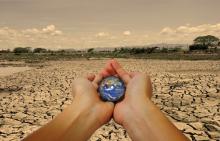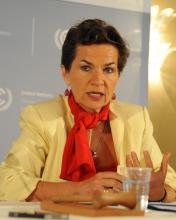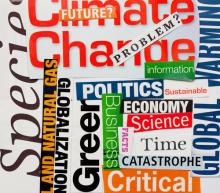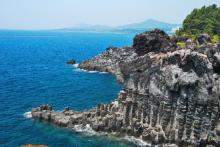Creation Care

COAL, NATURAL gas, petroleum. Thoughtlessly we call these substances “fuels”—fuels to burn for creating pleasant climates inside homes and offices; fuels to power appliances and engines. For years, like nearly everyone, I never thought beyond our mere use of these things. I neglected to consider their role in the Earth’s wider economy.
This all changed when my family moved to a Wisconsin peatland in 1972. Since then, conducting research there with my graduate students has produced four decades of discovery.
For thousands of years, wetland plants and algae in a bay of glacial Lake Waubesa took carbon dioxide from the atmosphere. They transformed it by photosynthesis into the carbon structure of life, eventually adding their remains, page upon page, to the accumulating peat. Eventually, this peat filled the bay for an area more than a mile long, reaching a depth of 95 feet at the present lake edge. When first I walked here, I saw the vibrant surface of plants and wetland creatures; now, in my mind’s eye, I also see the deep-layered remains of creatures below.
Also standing and walking here (much more gracefully than I) are sandhill cranes. These stately creatures, as conservationist Aldo Leopold observed, “stand, as it were, upon the sodden pages of their own history.” Elsewhere, the sodden pages of peat deposits have been cut over the ages to be dried for fuel. The early Romans saw this practiced by conquered peoples of northern and western Europe. Peat was also used as fuel in Ireland, Scotland, and northern Europe after forests were cleared for agriculture. And peat is the precursor of coal, transforming under geologic pressure into brown coal, bitumen, bituminous coal, and anthracite.
According to Reuters (via Chicago Tribune):
An earthquake of 7.9 magnitude struck off the Philippines on Friday and a tsunami warning has been issued for the region, the U.S. Geological Survey and the Pacific Tsunami Warning Center said.
The quake was centered off the east coast, 91 miles off the town of Guiuan in Samar province at a depth of about 20 miles, USGS said.
The tsunami warning was issued for the Philippines, Japan, Indonesia, Taiwan, Papua New Guinea and other islands in the Pacific including the U.S. state of Hawaii.
"An earthquake of this size has the potential to generate a destructive tsunami that can strike coastlines near the epicenter within minutes and more distant coastlines within hours," the Pacific Tsunami Warning Center said.
The quake struck just before 8:50 p.m. local time, the agency said.
There were no immediate reports of damage or injuries.

An examination of current public debate reveals a divide between the “brown agenda” of economic opportunity and the “green agenda” of environmental sustainability.
On the one hand, a “brown agenda” concerns economic opportunity, or in other words, the alleviation of poverty. In light of ongoing distress surrounding malnutrition, infant mortality, and unemployment, the brown agenda is important, urgent, and worthy of support. On the other hand, a “green agenda” relates to environmental sustainability and care for the Earth. As scientific reports affirm the reality of climate change, and in recognition of decreased access to clean water and biodiversity around the world, the green agenda is also deeply important, urgent, and worthy of support.
With the above thoughts in mind, one recognizes that both brown and green agendas are essential for the promotion of life. However, the proponents of each agenda seem to be at odds with the adherents of the other. For example, far too many with a “brown agenda” believe that the best way to reduce poverty is to reduce environmental controls, and to the contrary, those engaged with the “green agenda” too often place the needs of the Earth before the livelihoods of the poor and marginalized. As a result of this persistent struggle between “brown” and “green," progress on both agendas is limited, and our path toward economic opportunity and environmental sustainability is severely off course.
New results from the National Oceanic Atmosphere Administration show that July 2012 was the hottest summer on record for the United States, since accurate record keeping began in 1895. With an average temperature of 77.6 degrees Fahrenheit, last month's heat wave surpassed July 1936 (which recorded an average of 77.4) to become the steamiest summer around.
In a report on NBC, NOAA climate scientist Jake Crouch explains:
"These events are kind of what we'd expect with climate change, we'd expect expanding drought, we'd expect warm, record breaking temperatures… But it's kind of hard to pinpoint this month or past several months as a telltale sign that climate change is happening. The drought is more of a local factor and isn't necessarily driven by large scale climate change, but is impacting local temperatures. But we've also seen an increase in U.S. temperatures overall."

Last month, Rolling Stone magazine featured Bill McKibben's latest plea for climate sanity on its cover. And despite every pundit's whining proclamation that climate change is such a buzz-kill, Bill's article got forwarded, commented, tweeted, and otherwise pushed around the Internet more than anything else RS has put out lately.
So somebody out there is paying attention to climate change — even if the elites can't seem to grow a spine about it.
What I liked about Bill's article was that he lays out a clear, 3-pronged strategy for really doing something about climate change while there's still time.
If we do these three things, there's a possibility that we can reverse climate change, restore health to our skies, earth, and oceans, and move forward into a future where our grandkids can not just survive, but thrive.
Here's the plan.
Fred Krupp writes in The Wall Street Journal:
One scorching summer doesn't confirm that climate change is real any more than a white Christmas proves it's a hoax. What matters is the trend—a decades-long march toward hotter and wilder weather. But with more than 26,000 heat records broken in the last 12 months and pervasive drought turning nearly half of all U.S. counties into federal disaster areas, many data-driven climate skeptics are reassessing the issue.
Respected Republican leaders like Govs. John Kasich of Ohio and Chris Christie of New Jersey have spoken out about the reality of climate change. Rupert Murdoch's recent tweet—"Climate change very slow but real. So far all cures worse than disease."—may reflect an emerging conservative view. Even Exxon Mobil CEO Rex Tillerson, during public comments in June, conceded the reality of climate change while offering assurances that "there will be an engineering solution" and "we'll adapt."
Learn more here
Last weekend the New York Times published an op-ed by University of California-Berkeley physics professor, Richard Muller, who said he has changed his professional opinion on the cause of global warming:
“Call me a converted skeptic. Three years ago I identified problems in previous climate studies that, in my mind, threw doubt on the very existence of global warming. Last year, following an intensive research effort involving a dozen scientists, I concluded that global warming was real and that the prior estimates of the rate of warming were correct. I’m now going a step further: Humans are almost entirely the cause.”
Muller’s announcement sparked a media flurry throughout the week, and NPR’s Science Friday host, Ira Flatow, interviewed him today. You can listen to the audio recording HERE.

The Amish are by no means a perfect people, and there are dark sides to their history. Their example, however, does have much to teach us. How can we incorporate the best of Amish principles into our modern lives? To answer this, I did some reading. And some visiting. And some listening. I in no way pretend to be an expert on the Amish, but the more I read and visited and listened, the more I found to admire. The Amish are islands of sanity in a whirlpool of change.
Along the way, I discovered some Amish principles that we can all try to emulate. These principles (similar to the list that Wendell Berry laid out more than two decades ago in Home Economics) provide guidelines for a simpler, slower, more sustainable life. They offer me hope.
WHEN I READ about the dire impacts of global warming, I think about Howard Thurman. This might be perplexing to those more familiar with Thurman as the author of Jesus and the Disinherited, a book Martin Luther King Jr. was said to carry with him wherever he went.
While Thurman is well-known as a theologian, prolific writer, mystic, seminary professor, and religious leader, few realize that—well before environmentalism became mainstream—Thurman articulated a complex theology of the “original harmony of creation,” a harmony that human action had significantly disturbed. As he lamented in 1971, “Our atmosphere is polluted, our streams are poisoned, our hills are denuded, wildlife is increasingly exterminated, while more and more [humanity] becomes an alien on the earth and a fouler of [our] own nest.”
From the early years of his life at the start of the 20th century, Thurman’s faith was formed in intimate connection with the natural world—specifically, the Halifax River and northeast Florida woods and coastline, where he wandered and played as a boy. Thurman’s relationship with nature deepened when a heartbreaking event estranged him from organized religion. When he was 7, his beloved father died quite suddenly. The family pastor refused to conduct a funeral because his father was not a regular churchgoer, and a traveling minister who officiated at the service took the opportunity to expound on the dangers of dying “out of Christ”—to the small boy’s wonderment and rage, “preach[ing] my father into hell,” as he later recalled.

Bio: Executive Secretary of the U.N. Framework Convention on Climate Change, figueresonline.com
1. How much did religious leaders advocate against global warming at the United Nations climate talks this past winter in Durban, South Africa?
I have been very impressed over the past few years at how the faith community is getting more and more involved in climate issues; they are concerned about what humanity is doing to creation. In Durban we had, of course, Archbishop Tutu, who was there as the local leader of the faith community, but we also had probably the largest participation of the faith community we’ve ever had, from religions from around the world, trying to support the process.
2. So the U.S. is unusual in that the reality of climate change is sometimes contested on religious grounds here?
Yes, that is a unique situation.
3. How are military entities engaging with climate change?
It’s very interesting how the military has become acutely aware of the fact that climate represents, probably, the most difficult security issue that they are going to face over the next 20 years, just because of migration. We see areas that are going to be underwater, that are going to be in drought—there is going to be a massive migration such as we have never seen, which represents a severe security problem for what are currently stable states.
The U.S. military has already done quite a few studies about the implications of climate change on the security and the borders of the United States. And they, I think, are taking on much more of a progressive role; they’re wanting to contribute to addressing climate change. They are already looking at investing in new technologies that are much more efficient in the use of energy. They’re actually taking good leadership.

IN EARLY JUNE, a team of prominent biologists, ecologists, paleontologists, and climatologists published a long article in our most important scientific journal, Nature. It concluded that people have so disturbed the operations of the planet that it is nearing—perhaps within decades—a “state shift” to a new biological paradigm unlike any human civilization has ever encountered.
“It really will be a new world, biologically, at that point,” warns Anthony Barnosky, professor of integrative biology at the University of California, Berkeley, and lead author of the study. “The data suggests that there will be a reduction in biodiversity and severe impacts on much of what we depend on to sustain our quality of life, including, for example, fisheries, agriculture, forest products, and clean water. This could happen within just a few generations.”
For many of us who have long studied these questions, there’s nothing that surprising in the conclusions. I mean, we’ve already put enough carbon in the atmosphere to melt 40 percent of the summer sea ice in the Arctic, to make the ocean 30 percent more acidic, and to turn the atmosphere 5 percent wetter, thus loading the dice for drought and flood.
What’s surprising is not the science. It’s the endless lack of reaction to it. The secular press barely covered the Nature study—The New York Times discussed it in a blog post, not in the paper. And I didn’t hear any reaction at all from the nation’s clerics, though it strikes me this kind of story strikes much closer to the heart of our theology than most of the things we do hear clerics opining about. Contraception? Okay, sort of, you can kind of find something about it in the Bible. Homosexuality? The occasional passing reference. But the whole first page of the thing is about nothing but creation, the fact that God made everything around us, pronounced it good, and told us to take care of it.

IF YOU HAVE ever been to Jeju, you will understand why it is called a paradise. Lying in the waters south of the Korean mainland, this volcanic island is stunningly beautiful, from its clean mountain streams to its placid coral reefs. Jeju’s legendary female deep-sea divers harvest clams, abalone, and seaweed, relying on lung power alone. The island is also a spiritual place, said to be the body of Korea’s creation goddess, Mago. Jeju has been designated a UNESCO World Heritage Site and a World Biosphere Reserve.
Since January 2011, it’s also been the site where a $970 million naval base is being constructed by the South Korean government, with the help of giant construction corporations such as Samsung. The base, located in the small farming and fishing village of Gangjeong, will occupy a unique three-quarter-mile stretch of coastal wetland, threatening an ecological system that harbors several endangered species. The naval base construction also contributes to increasing military tensions in Asia, raising the risk of a devastating war in the region. Today, islanders, religious leaders, and peace activists are calling attention to dangers caused by joint U.S.-South Korean militarization.
The base is slated to be home to 20 warships, including submarines, aircraft carriers, and destroyers, several of them equipped with missile defense technology with the stated goal of protecting South Korea’s sea lanes and shielding against attack from North Korea. Civilian cruise liners will also be able to dock, according to the government. South Korean naval official Ku Okhyoe told a press conference last fall that U.S. military ships will be allowed to dock at the base only temporarily; Ku insisted, “The base is not intended for a certain country.”
From The Guardian:
The Gulf of Mexico oil spill continues to plague BP more than two years after the disaster as the company has revealed another $847m (£538m) hit to cover rising legal costs.
The additional charge for the second quarter brings the total bill for the fatal Deepwater Horizon incident to $38bn, BP said.
BP is struggling to shake off the reputational blow of the April 2010 Macondo blow-out after recently coming under further fire in a report from a US government safety panel.
Learn more here

Whether churchgoers realize it or not, the trees in their churchyards have religious roots.
Those tall, thin-branched trees on the corner of this city's Episcopal Church Center of Utah, Purple Robe Black Locusts, were probably named after a biblical reference to John the Baptist eating locusts and honey.
Nearby, the crab apple tree just outside the Episcopal Cathedral Church of St. Mark produces a small, sour fruit used by 15th-century monks to treat diarrhea, dysentery, and gallstones.
And the flowers of a nearby dogwood tend to bloom around Easter.
“My hope,” said University of Utah biology professor Nalini Nadkarni, “is [worshippers] will realize that nature and trees are as much a part of their sacred ground and worthy of reverence as what goes on inside a cathedral or church.”
Writing for The Huffington Post, Joanna Zelman reports on a new NASA study:

Good news: Evangelical Christians are stepping back up to overcome the climate crisis.
After months of careful preparation, a new national advocacy initiative called Young Evangelicals for Climate Action (Y.E.C.A.) has just gone live.
In seeking to live as Christ’s disciples, Y.E.C.A. has come to see the climate crisis not only as a pressing challenge to justice and freedom, but also as a profound threat to “the least of these” with whom Jesus identifies in Matthew 25. The early effects of climate change are already impacting many of our neighbors, both in the U.S. and around the world, and our time to act is running short.
Mother Jones examine the growing phenomenon of urban farms, and the effects that they are having on their communities:
"There's been a growing body of research that suggests that urban farming and greening not only strengthen community bonds but also reduce violence. In 2000, Philadelphia had 54,000 vacant lots, and so the Pennsylvania Horticultural Society reclaimed 4,400 of them, mowing lands, providing upkeep, planting trees and gardens, and erecting three-foot-high fences that served no purpose other than as a kind of statement that this land now belonged to someone.
The greening of these parcels (just 8 percent of the vacant land in the city) had an unexpected effect: Over the course of 10 years, it reduced shootings in the areas surrounding these renewed lots. Part of it was practical: The vacant lots had previously been hiding places for guns. But as Charles Branas, an epidemiologist at the University of Pennsylvania who released a study on the project late last year, says, 'People just became more in touch with their neighbors. People felt more connected to each other.'"
Learn more here
For The Daily Beast, Mark Hertsgaard asks why parents aren't taking the potential effects of climate change on their children's lives more seriously:
"Beyond the distress and discomfort, the record-breaking heat raises a puzzling question for anyone who cares about the future of our young people. The laws of physics and chemistry—the fact that carbon dioxide remains in the atmosphere for decades after being emitted—mean that man-made global warming is just getting started on this planet. As a result, my Chiara and millions of other youth around the world are now fated to spend the rest of their lives coping with the hottest, most volatile climate in our civilization’s 10,000-year history. Think of them as Generation Hot.
Why, then, are so few parents taking action to try to protect their beloved children from this gathering catastrophe? And why has no one asked them to?"
Learn more here
Bill Nye the Science Guy may not be a real scientist, but he tells CNN's news anchor that he knows how to read a chart, and when you look at the data on climate change, journalistic objectivity shouldn't try to obscure the facts. Watch Nye respond to climate change skeptics and discuss the conditions that led to the Colorado wildfires. [via CNN]